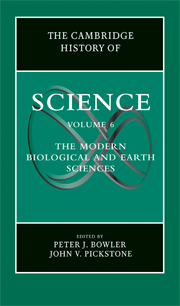Book contents
- Frontmatter
- 1 Introduction
- PART I WORKERS AND PLACES
- PART II ANALYSIS AND EXPERIMENTATION
- PART III NEW OBJECTS AND IDEAS
- 20 Plate Tectonics
- 21 Geophysics and Geochemistry
- 22 Mathematical Models
- 23 Genes
- 24 Ecosystems
- 25 Immunology
- 26 Cancer
- 27 The Brain and the Behavioral Sciences
- 28 History of Biotechnology
- PART IV SCIENCE AND CULTURE
- Index
- References
26 - Cancer
from PART III - NEW OBJECTS AND IDEAS
Published online by Cambridge University Press: 28 November 2009
- Frontmatter
- 1 Introduction
- PART I WORKERS AND PLACES
- PART II ANALYSIS AND EXPERIMENTATION
- PART III NEW OBJECTS AND IDEAS
- 20 Plate Tectonics
- 21 Geophysics and Geochemistry
- 22 Mathematical Models
- 23 Genes
- 24 Ecosystems
- 25 Immunology
- 26 Cancer
- 27 The Brain and the Behavioral Sciences
- 28 History of Biotechnology
- PART IV SCIENCE AND CULTURE
- Index
- References
Summary
In January 1994, the journal Scientific American published a review essay on cancer that opened with a quotation from John Bailar III, a famous epidemiologist at McGill University, claiming that the “war on cancer” had not been won. Bailar was referring to the anticancer campaign launched by President Richard Nixon in 1971 as a civilian alternative to the Vietnam War and as a Republican follow-up to President Lyndon Johnson’s War on Poverty. Bailar’s argument rested on statistical data from the National Cancer Institute suggesting that U.S. cancer death rates, adjusted for the aging population, went up seven percent during the twenty-five years of a war that was waged by means of research investments – both biological and clinical.
That article reminds us that cancer remains the visible, frightening, and “scientific” disease it has been for more than a century. More than tuberculosis or syphilis, which were considered conquered after World War II, cancer was the scourge of the twentieth century. From the late nineteenth century, the growing incidence of various types of tumors, as well as the limitations of existing therapies, have been at the center of Western medical discourses increasingly concerned with relatively wealthy and aging populations. Since then, experts have viewed the formation of tumors as a problem of unlimited multiplication of cells, a process that might be controlled by physical or chemical means derived froma better understanding of cell growth and cell division.
- Type
- Chapter
- Information
- The Cambridge History of Science , pp. 486 - 503Publisher: Cambridge University PressPrint publication year: 2009
References
- 3
- Cited by



